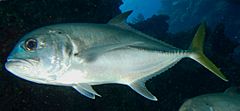Crevalle jack facts for kids
Quick facts for kids Crevalle jack |
|
|---|---|
 |
|
| Scientific classification | |
| Kingdom: | |
| Phylum: | |
| Class: | |
| Order: | |
| Suborder: |
Percoidei
|
| Superfamily: |
Percoidea
|
| Family: |
Carangidae
|
| Genus: |
Caranx
|
| Species: |
C. hippos
|
| Binomial name | |
| Caranx hippos (Linnaeus, 1766)
|
|
| Synonyms | |
|
|
The Crevalle jack, also known as Caranx hippos, is a speedy fish that lives in the ocean. You can find them in the western Atlantic Ocean, from Nova Scotia all the way down to Uruguay. They also live in the eastern Atlantic, from Portugal to Angola.
This fish has a big, round head and large eyes. Its body is dark and silvery, sometimes with hints of blue-green or green-gold colors. Crevalle jacks can grow to be over three feet long. However, most are usually between one and two and a half feet. They typically weigh 15 to 30 pounds. The largest one ever caught weighed 51 pounds off the coast of Florida!
Crevalle jacks lay their eggs far out in the ocean. This happens from early March to early September. When they are young, these fish swim together in huge groups called schools. As they get older, they often prefer to swim alone. Many animals that hunt near the water's surface, like bigger fish and seabirds, prey on crevalle jacks. These fish hunt during the day, eating different kinds of smaller fish and invertebrates (animals without backbones).
Some other common names for the crevalle jack include blacktailed trevally, cabalo, green jack, horse mackerel, horse-eye jack, kingfish, and just trevally.
Where Crevalle Jacks Live
The crevalle jack lives in both shallow waters near the coast and deeper waters further out in the ocean. Older, larger fish usually prefer the deeper areas.
In coastal areas, you can find crevalle jacks in shallow flats, sandy bays, beaches, and areas with seagrass. They also live near shallow reefs and in lagoons. These fish can live in water with very different salinity levels (how salty the water is). This shows they can adapt to many types of water environments.
What Crevalle Jacks Eat
The crevalle jack is a strong predator. This means it hunts and eats other animals. Most of their diet, at all ages, is made up of smaller fish. Different invertebrates are also part of their diet, but usually less important than fish.
Because their diet changes a lot depending on their age and where they are, scientists used to think crevalle jacks just ate whatever was available. They are not picky eaters!
Images for kids
-
Several crevalle jacks over a reef in Florida
-
Crevalle jacks swimming in the Georgia Aquarium
-
A school of crevalle jack swarming around a Caribbean reef shark
See also
 In Spanish: Caranx hippos para niños
In Spanish: Caranx hippos para niños





